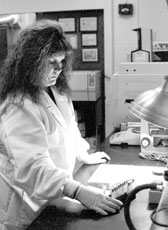Crime lab ‘expertise’ helps in meth cases

Stephanie Hovine, forensic analyst, works in Southern´s crime lab. The lab is used by law enforcement agencies to process information.
In semi-retirement, Dr. Phillip Whittle works full-time and then some.
As director of the Southwest Missouri Regional Crime Laboratory, Whittle has been accustomed to 70-hour and 80-hour work weeks for years. He had planned to retire Jan. 1, but hasn’t worked less than 55 hours per week since.
“I’m working on a meth lab now,” Whittle said.
“We’re in the process of finishing two labs that I hope to have typed by the end of the day.”
According to statistics provided by Whittle, area clandestine methamphetamine lab cases have been more numerous with each passing year. The crime lab processed 182 lab cases in 2002, compared to just 52 lab cases five years earlier.
“For some reason or another, the labs are really popular in this part of the state,” Whittle said.
“In other areas, it’s beginning to decline. They haven’t started to decline here yet.”
Whittle said the Drug Enforcement Administration reported that Missouri closed more clandestine meth operations in 2001 than any other state. According to state records for the same year, Whittle said Jasper County had more meth lab seizures than any other Missouri county.
“The meth problem does take a considerable amount of our resources,” said Dean Dankelson, prosecuting attorney for Jasper County. “It takes everybody’s resources. We’re fortunate to have a local facility that has an extremely high level of expertise to help with our cases.”
Whittle said while drug identification may not have been the crime lab’s primary goal, it has become the lab’s primary function.
“In a given year, 70-75 percent of our analysis time is devoted to drug analysis,” Whittle said.
The crime lab has a backlog of 600 to 700 meth cases.
“If I didn’t get another case in the next two years, I doubt that I’d catch up,” he said.
Whittle said substances believed to be methamphetamine are analyzed with a battery of tests, and samples are taken from different parts of a given specimen to ensure that the tests are representative of the evidence.
Whittle said reducing the chance of false identification is the reason for such rigor.
“There is a minimum of three different analytical techniques that we use before it is determined to be a drug,” he said.
Whittle said the tests don’t merely duplicate results, but that the results reinforce the validity of each of the tests.
“If any of the tests show discrepancies, we have to go back and resolve those differences,” he said.
“If there are any questions, we won’t call it a drug.”
Whittle said there are some important precautions that are taken when handling suspected meth samples. Analysts always use gloves, but Whittle said most samples are not so volatile that there is a risk of inhalation.
“Most samples would not require wearing a mask of some sort,” he said.
“To go into a [meth] laboratory that has operated, a mask may be appropriate because of the volatile materials. With meth labs, a lot of the risk is some of the by-products.”
Those by-products, like strong acids, bases and red phosphorus, require the expertise of individuals trained in hazardous materials management.
Before area law enforcement agencies had their own hazardous materials personnel, Whittle himself was called into the field to collect and process evidence from a clandestine lab.
“I have done probably 150 to 200 labs myself,” he said.
“The [Missouri] Department of Natural Resources in conjunction with the Highway Patrol labs have trained numerous people across the state, in terms of the basic things they’re going to see and how to handle them. That’s helped us a lot.”
Sometimes samples are safe enough to be returned to the agency that submitted them.
“By safe, I mean if it’s to be passed around to a jury to see, we’ll return that evidence to the department,” Whittle said.
Hazardous remnants of meth production are usually disposed of after analysis.
The lab serves approximately 50 agencies in 10 counties in Southwest Missouri. There are seven agencies in Southeast Kansas that use the crime lab’s services.
The crime lab is located at the Anderson Justice Center on Missouri Southern’s campus. Southern provides the space and utilities for the lab, but no College funds are used for its operation. The funding for the lab comes from state grants and contractual payments from the law enforcement agencies that use the crime lab’s services. A recent equipment upgrade was possible through federal grant money received for the current federal fiscal year.
“Without modern instruments, thanks to grants, we’d be a lot further behind than we are now,” Whittle said.
Your donation will support the student journalists of Missouri Southern State University. Your contribution will allow us to purchase equipment and cover our annual website hosting costs.















